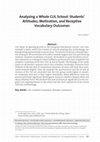Papers by Mario Arribas García

Latin American Journal of Content & Language Integrated Learning, 2016
CLIL keeps on gaining ground in the European educational context, one clear example is Spain, whe... more CLIL keeps on gaining ground in the European educational context, one clear example is Spain, where the number of schools adopting this methodology has kept growing exponentially in recent years. The present study has a dual perspective looking at the motivation of students towards English and CLIL and showing students' receptive vocabulary outcomes. All students (n=403) enrolled in secondary education in a bilingual school fulfilled a questionnaire and completed two receptive vocabulary level tests (VLT 2k and 3k bands). The findings of the study report on all learners' opinions and it also correlates vocabulary outcomes from students of the last year of compulsory education (16 years old) with their motivation towards English. Once we analysed the questionnaire and the 2k and 3k versions of the VLT, we concluded that the CLIL group scored higher in receptive vocabulary tests due to their higher motivation, albeit differences were not found statistically significant (Kolmogorov-Smirnov-Lilliefors, Shapiro-Wilk, and Mann-Whitney tests). We attribute this lack of statistical significance to the irregular CLIL implementation in the school and the short experience of the school with this methodology.

espanolEste articulo pretende (i) analizar el vocabulario productivo de 101 estudiantes espanoles... more espanolEste articulo pretende (i) analizar el vocabulario productivo de 101 estudiantes espanoles de ingles como lengua extranjera de 4o de ESO en dos centros de educacion secundaria situados en el norte de Espana en dos tipos de instruccion AICLE y no-AICLE y (ii) comparar los resultados obtenidos por los participantes de acuerdo con su sexo. Para medir el vocabulario productivo de los estudiantes se utilizo la version paralela del Productive Vocabulary Levels Test (PVLT) (Laufer & Nation, 1995, 1999). Los resultados muestran que los alumnos AICLE obtienen puntuaciones significativamente mejores que sus companeros no-AICLE siendo el tamano del vocabulario productivo en ambos grupos inferior a 1000 palabras. En lo que respecta a las diferencias en cuanto al sexo no se constatan diferencias significativas entre los chicos y las chicas. Estos resultados parecen indicar que el enfoque AICLE resulta beneficioso para el aprendizaje del vocabulario productivo en una lengua extranjera. Eng...

This paper aims at investigating (i) the productive vocabulary knowledge of 38 10th grade (4th ES... more This paper aims at investigating (i) the productive vocabulary knowledge of 38 10th grade (4th ESO) EFL Spanish students in two secondary schools located in the north of Spain, (ii) analysing the results obtained according to sex-based differences among the participants and (iii) its pedagogical implications for students’ understanding of written and spoken discourse in English. We used the parallel version (version A+ version C) of the Productive Vocabulary Levels Test (PVLT) (Laufer and Nation 1995, 1999) as the instrument to measure students’ productive vocabulary knowledge. Our results reveal that our students’ productive vocabulary size is below 1,000 words. As for sex-based differences, girls’ mean scores are higher than boys’ but the differences between both sexes are not statistically significant. These findings also indicate that most of the students in the present study could have problems to understand written and spoken discourse in English due to their low scores in the...

CLIL keeps on gaining ground in the European educational context, one clear example is Spain, whe... more CLIL keeps on gaining ground in the European educational context, one clear example is Spain, where the number of schools adopting this methodology has kept growing exponentially in recent years. The present study has a dual perspective looking at the motivation of students towards English and CLIL and showing students' receptive vocabulary outcomes. All students (n=403) enrolled in secondary education in a bilingual school fulfilled a questionnaire and completed two receptive vocabulary level tests (VLT 2k and 3k bands). The findings of the study report on all learners' opinions and it also correlates vocabulary outcomes from students of the last year of compulsory education (16 years old) with their motivation towards English. Once we analysed the questionnaire and the 2k and 3k versions of the VLT, we concluded that the CLIL group scored higher in receptive vocabulary tests due to their higher motivation, albeit differences were not found statistically significant (Kolmogorov-Smirnov-Lilliefors, Shapiro-Wilk, and Mann-Whitney tests). We attribute this lack of statistical significance to the irregular CLIL implementation in the school and the short experience of the school with this methodology.

This paper aims at investigating (i) the productive vocabulary knowledge of 38 10 th grade (4 th ... more This paper aims at investigating (i) the productive vocabulary knowledge of 38 10 th grade (4 th ESO) EFL Spanish students in two secondary schools located in the north of Spain, (ii) analysing the results obtained according to sex-based differences among the participants and (iii) its pedagogical implications for students' understanding of written and spoken discourse in English. We used the parallel version (version A+ version C) of the Productive Vocabulary Levels Test (PVLT) Nation 1995, 1999) as the instrument to measure students' productive vocabulary knowledge. Our results reveal that our students' productive vocabulary size is below 1,000 words. As for sex-based differences, girls' mean scores are higher than boys' but the differences between both sexes are not statistically significant. These findings also indicate that most of the students in the present study could have problems to understand written and spoken discourse in English due to their low scores in the PVLT.









Uploads
Papers by Mario Arribas García